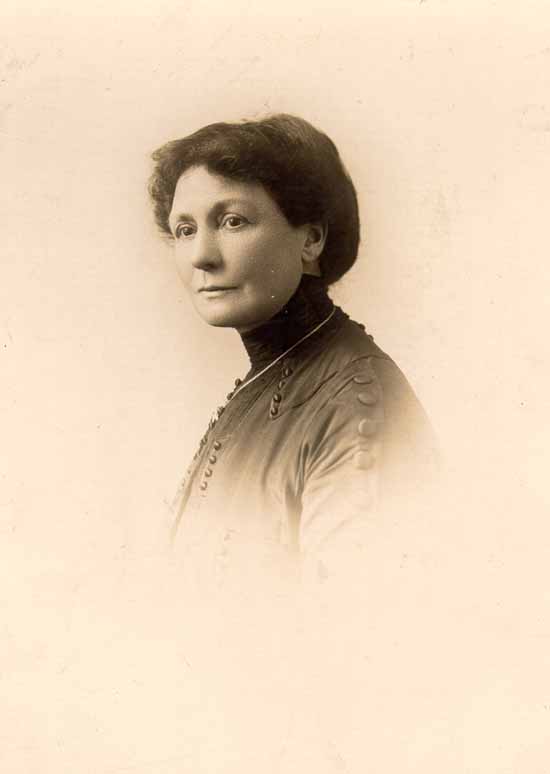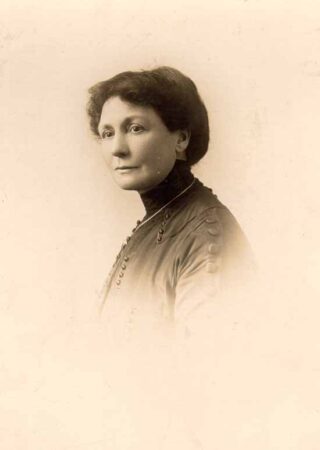- Entry type: Person
- Entry ID: IMP0054
Deakin, Elizabeth Martha Anne (Pattie)
- CBE
- Maiden name Browne, Elizabeth Martha Anne (Pattie)

- Occupation Philanthropist
Summary
At age 19 in 1882 Pattie Browne married Alfred Deakin who became the youngest ever cabinet minister in Australia, in 1883. He was Prime Minister of Australia in 1903-1904, 1905-1908, and 1909-1910. Throughout her married life, Pattie devoted herself to her family and charity work, especially in the area of child welfare.
After World War I, Pattie refused to accept an honour for her philanthropic work. Her husband Alfred Deakin also declined all honours and honorary degrees during his political life. But just prior to her death on 30 December 1934 Pattie accepted the award of the order of Commander of the British Empire (civil), which was awarded to her posthumously in January 1935.
Details
Pattie Browne was born at Camp Hill, Tullamarine Victoria on 1st January 1863. She was the eldest daughter and third child of the eleven children of Hugh Junor Browne and his wife Elizabeth Browne (née Turner). Born Elizabeth Martha Anne, she was always known as Pattie. Until the age of 12, Pattie was educated by a governess and then when the family moved to East Melbourne she attended Mrs Philippa James Grantown House. Although Pattie studied for her matriculation she did not sit the exam, and continued to learn music, singing and drawing after finishing school.
Pattie met Alfred Deakin in 1877 at the Victorian Association of Progressive Spiritualists Sunday School where he was a teacher. On 3 April 1882, at the age of 19, Pattie married barrister Alfred Deakin, son of William and Sarah Deakin (née Bill) who was a member of the Legislative Assembly for Victoria. There were three children of the marriage – Ivy (1883-1970) who married Herbert Brookes in 1905; Stella (1886-1976) who married (Sir) A. C. David Rivett in 1911; and, Vera (1891-1978) who married (Sir) Thomas W. White in 1920. Initially in her marriage, Pattie developed a close relationship with Alfred’s only sister and confidante Catherine (Katie), but the relationship deteriorated.
Pattie was often ill and a poor traveller, even so she accompanied her eminent husband whenever possible and cared for him during his long illness. As her daughters established lives of their own, Pattie was able to devote more of her energy to public life, but always kept her family as the centre of her life. In 1907 in London, Pattie gave her first public speech after Lady Jersey, wife of a former governor of New South Wales asked her to address a gathering of a hundred women.
Prior to this time in Melbourne Pattie was president and a most generous and active supporter, of the Victorian Neglected Children’s Aid Society. She was a member of the very active committee of the Queen’s Fund formed in 1887 (still operating in 2003, its purpose “limited solely for the relief of women in distress”).
In 1907 Pattie chaired the nursery and kindergarten committee for the Australian Exhibition of Women’s Work, held at the Exhibition Building. The exhibition was based on the cooperation of community workers and women writers, musicians and artists. The popularity of the model creche, which Pattie herself ran, helped afterwards in the establishment of the Association of Creches, and she became its first president. The Free Kindergarten Union was formed too in this way, Pattie becoming the first president. Proceeds from the Exhibition helped establish the Bush Nursing Association and Pattie became a member of the Committee. For 20 years Pattie worked actively in the Melbourne District Nursing Society as president and then was made a life vice-president. With her husband she helped establish the Guild of Play for Children’s playgrounds, helping to provide play areas for children in the inner city suburbs. In 1909 she had gained her St Johns Ambulance certificate with honours and was presented with the insignia of an associate of St John of Jerusalem.
In 1912 Pattie was invited to be president of the Lyceum Club, a new club for women graduates and other women who had distinguished themselves in art, music, literature, philanthropy or public service.
From 1915 until 1919 Pattie helped set up and run the Soldiers’ Refreshment Stall or Anzac Buffet, at first in a bell tent outside the No 5 General Hospital in St Kilda Road Melbourne. It was staffed by volunteers for men leaving for, or returning from, the war. The depot ‘in the first year provided comforts for 4000 soldiers a week in the matter of meals, clothing, motor trips, and monetary loans and gifts’.
After World War I Pattie continued her philanthropic work; she was invited to be the first president of the Girl Guides and she became the only female member of the Australian Imperial Forces Canteens Fund Trust and trustee of the Sir Samuel McCaughey bequest for the education of the children of decreased or disabled soldiers. She held her position until her death in 1934, when her daughter Vera Deakin White took her place on these two Committees.
Alfred Deakin retired from Parliament in 1913 due to ill health. Pattie cared for him during his long illness and he died in 1919. Pattie died at her much loved house ‘Bellara’ Point Lonsdale just before her 71st birthday and was buried beside her husband at the St Kilda cemetery.
Archival resources
- National Library of Australia, Manuscript Collection
- Public Record Office Victoria, Victorian Archives Centre
- National Library of Australia
Digital resources
Published resources
- Book
-
Resource
- 1891 Women's Suffrage Petition, Parliament of Victoria
- Trove: Deakin, Elizabeth Martha Anne (1863-1934), http://nla.gov.au/nla.party-728060
-
Site Exhibition
- Faith, Hope and Charity Australian Women and Imperial Honours: 1901-1989, Australian Women's Archives Project, 2003, http://www.womenaustralia.info/exhib/honours/honours.html
Related entries
-
Presided
-
Founding President
-
Related Women
-
Daughter
-
Membership
-
Related Cultural Artefacts
